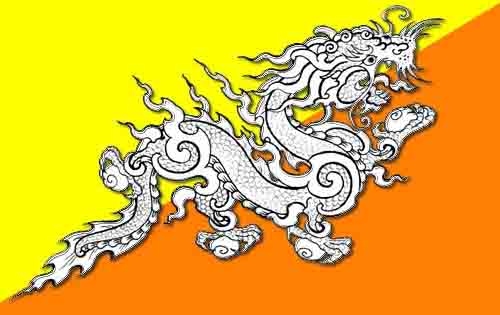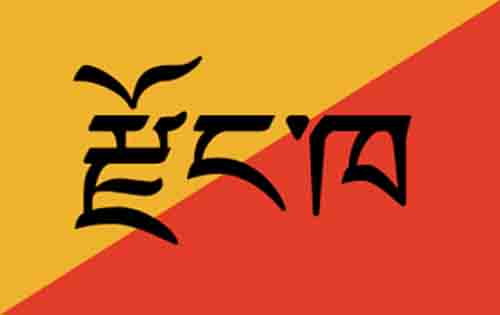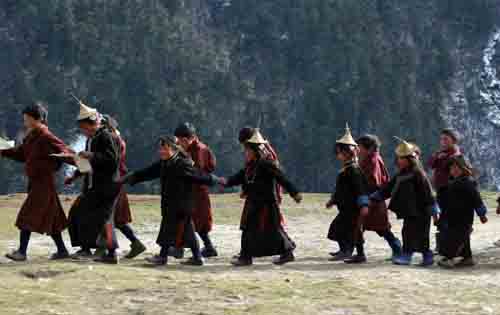
National Emblem
The National Emblem of Bhutan is circle that projects a double diamond thunderbolt placed above the lotus. There is a jewel on all sides with two dragons on vertical side. The thunderbolts represents the harmony between secular and religious while the lotus power symbolizes purity. The jewels signifies the sovereign power while the dragon (male and female ) stands for the name of the country Druk Yul or land of thunder dragon.

NATIONAL FLAG
The National flag is a rectangle in shape that is divided into two parts diagonally. The upper yellow half signifies the secular power and authority of the king while the lower saffron-orange symbolize the practice of religion and power of Buddhism , manifested in the traditional of Druk Kagyu. The dragon signifies the name and the purity of the country while the jewels in its claws stand for the wealth and perfection of the country .

LANGUAGE
Bhutan is a multi-lingual society. Today, about 18 languages and dialects are spoken all over the country. The state language is Dzongkha which in the olden times was spoken by people. In the olden times was spoken by people who worked in the Dzongs that was the seat of temporal and and introduced as the national language of Bhutan. The national language is Dzongkha, but the native language of the Ngalops of western Bhutan. Dzongkha literally means the language spoken in the Dzongs, massive fortresses that serve as the administrative centers and monasteries. Two other major languages are the sharchop in the east, while Lhotshamkha (nepali) is spoken by the southern Bhutanese of Nepali origin.

PEOPLE
People from different parts of Bhutan with different ways of live style they live, language they speaks, food they eats and the cloths they wear made them adopt their own ways of life. The groups of people Bumthaps and the Khengpas of Central Bhutan, the Kurtoeps in Lhuentse, the Brokpas and the Bramis of Merak and Sakteng in eastern Bhutan, the Doyas of Samtse and finally the Monpas of Rukha villages in WangduePhodrang. Together the multiethnic Bhutanese populate.
SOCIETY
The way we dress, eat, talk and behave is quite different from the way people in other countries do. This difference is a result of our customs which are commonly known as Driglam Namzha. We can, therefore, say that Driglam Namzha is a set of society customs and traditions that every Bhutanese follows so as to fit able to live together peacefully. Driglam Namzha is important for us to know because it reaches us how to conduct ourselves in our society.
People from different parts of Bhutan with different ways of live style they live, language they speaks, food they eats and the cloths they wear made them adopt their own ways of life. The groups of people Bumthaps and the Khengpas of Central Bhutan, the Kurtoeps in Lhuentse, the Brokpas and the Bramis of Merak and Sakteng in eastern Bhutan, the Doyas of Samtse and finally the Monpas of Rukha villages in WangduePhodrang. Together the multiethnic Bhutanese populate.
SOCIETY
The way we dress, eat, talk and behave is quite different from the way people in other countries do. This difference is a result of our customs which are commonly known as Driglam Namzha. We can, therefore, say that Driglam Namzha is a set of society customs and traditions that every Bhutanese follows so as to fit able to live together peacefully. Driglam Namzha is important for us to know because it reaches us how to conduct ourselves in our society.
RELIGION
Just as the kingdom’s history is characterized by religious landmark, the influence of religion is highly visible in everyday life of the lay population. Bhutan is a spiritual nation with hundreds of scared monasteries, stupas, religious institutions, prayer flags and prayer wheels which dot the countryside and provides a strong infrastructure and atmosphere for the teachings of their living faith. In both urban and rural Bhutan, religious ceremonies and rituals are performed regularly and with reverence. The horoscope of Bhutanese life is drawn from the scriptures. National and regional festival, coinciding with the seasons, is major events for entire region. The Buddhist world thus regards the kingdom with special importance as the last bastion of Mahayana Buddhism. Bhutanese constitution guarantees freedom of religion. citizens and visitors are free to practice any form of worship so long as it does not image on the rights of others. Christianity and Hinduism are also present in the country.
Just as the kingdom’s history is characterized by religious landmark, the influence of religion is highly visible in everyday life of the lay population. Bhutan is a spiritual nation with hundreds of scared monasteries, stupas, religious institutions, prayer flags and prayer wheels which dot the countryside and provides a strong infrastructure and atmosphere for the teachings of their living faith. In both urban and rural Bhutan, religious ceremonies and rituals are performed regularly and with reverence. The horoscope of Bhutanese life is drawn from the scriptures. National and regional festival, coinciding with the seasons, is major events for entire region. The Buddhist world thus regards the kingdom with special importance as the last bastion of Mahayana Buddhism. Bhutanese constitution guarantees freedom of religion. citizens and visitors are free to practice any form of worship so long as it does not image on the rights of others. Christianity and Hinduism are also present in the country.





